Lord Howe Woodhens have a remarkable story, a story of hope that we humans can successfully work together to right some environmental wrongs.
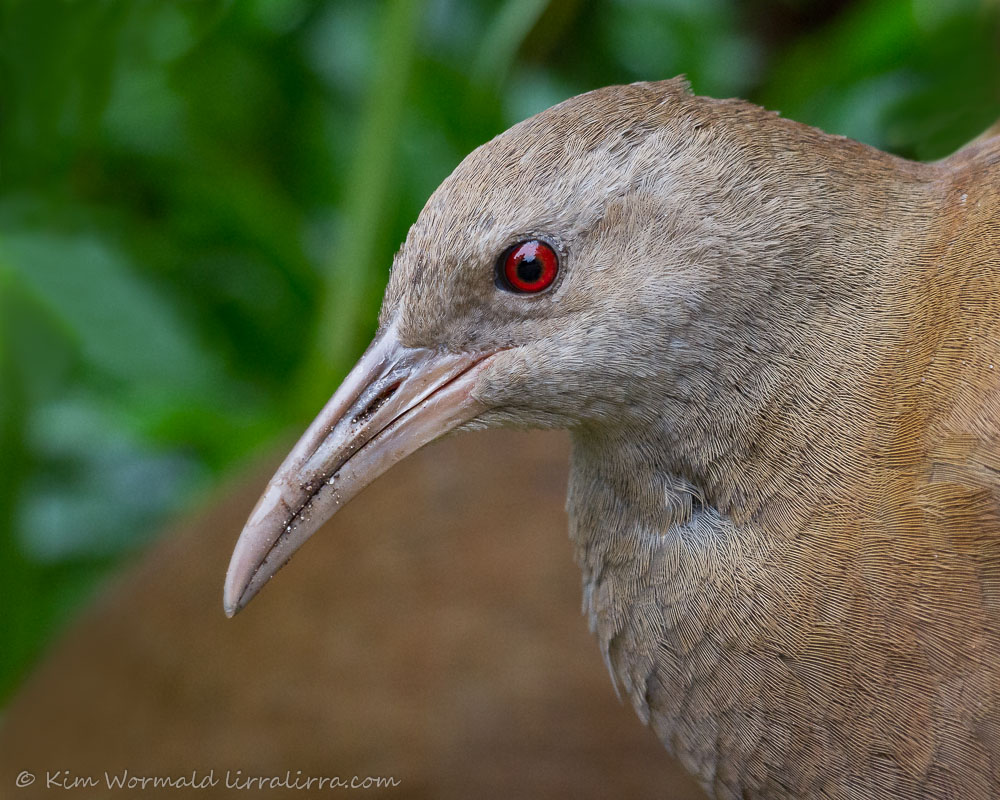
Lord Howe Woodhen (Tricholimnas sylvestris)
Canon 7D, 100-400mm L IS USM, 1/500, f/5.6, ISO 1600, focal length 400mm
Lord Howe Island Woodhens were plentiful when explorers first discovered the island in 1788, and so were 14 other species, nine of which later became extinct – the flightless woodhen came within 30 birds of joining them. The original predators were the explorers and settlers themselves, and later the pigs, cats and rats that were introduced to the island. Those 30 birds had retreated to areas at the top of Mt Gower and Mt Lidgbird before a few individual birds were taken to start a captive breeding program. That program, along with the eradication of pigs and the banning of cats has enabled the numbers to increase to approximately 300 birds. Rats on the island are still being dealt with systematically.
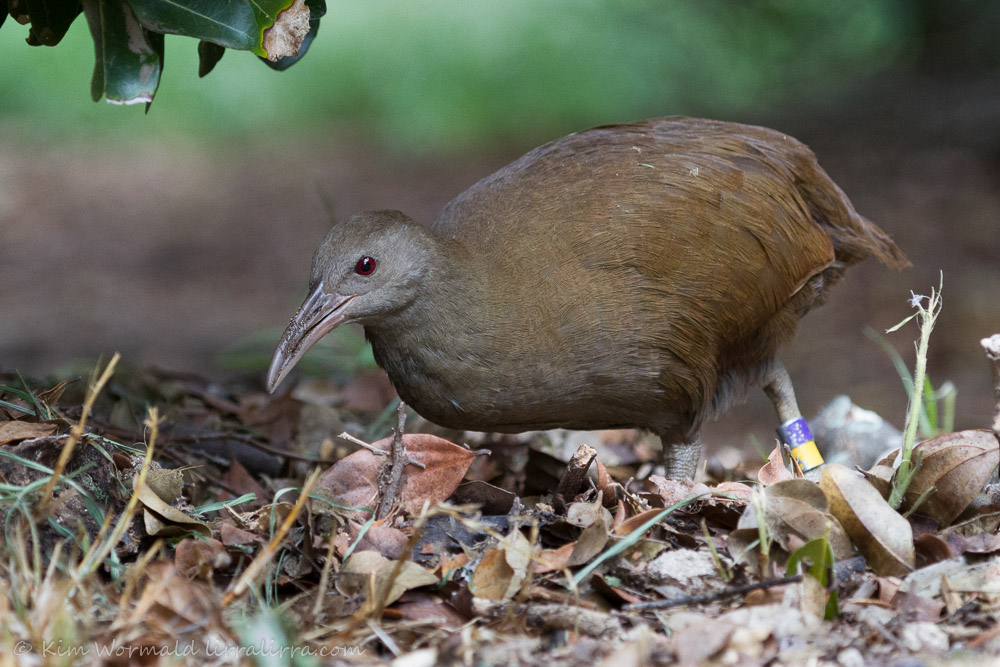 Lord Howe Woodhen (Tricholimnas sylvestris)
Lord Howe Woodhen (Tricholimnas sylvestris)
Canon 7D, 100-400mm L IS USM, 1/250, f/5.6, ISO 1600, focal length 190mm
They are comical little hens to watch as they use their bills to flick away leaf litter and probe for delectable bugs and grubs. Some bird photographers ‘clean’ bills using a cloning tool but I like seeing birds in working mode and the woodhens’ sturdy down-curved bill is an excellent tool. As I watched I was reminded of kiwi and weka in New Zealand. Woodhens are about 32-42cm long with the males slightly larger than the females. I like the boldness of their bright red eye and their bright chestnut orange sides. I took many images trying to get a shot of them foraging under bushes, as in the image above. The overall canopy created by the shrubs is lost in the crop but I hope that I haven’t lost too much of the secluded feeling – I’ll post another image that I hope will show it more clearly.
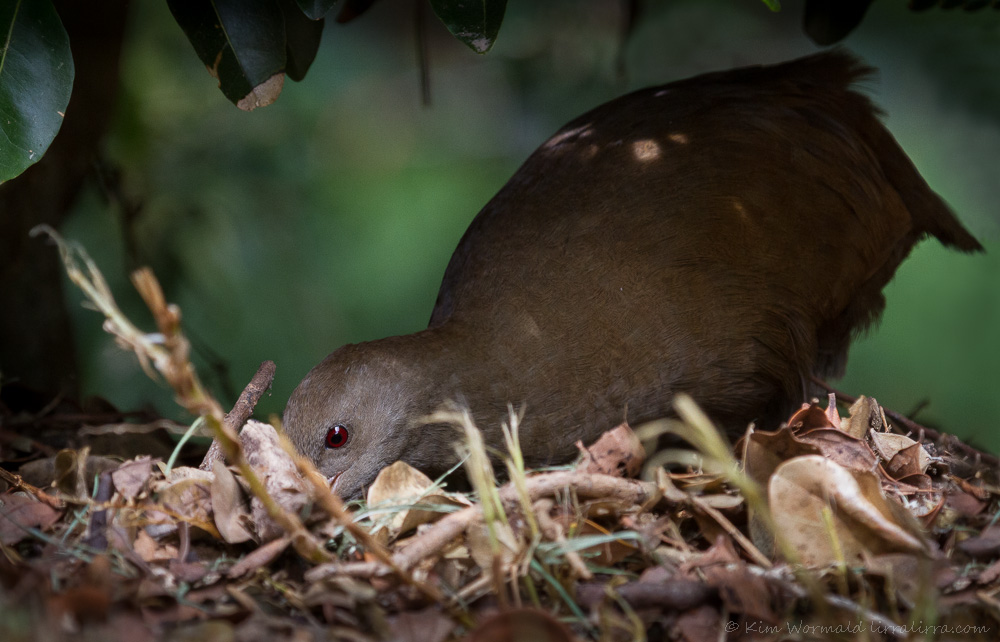 Lord Howe Woodhen (Tricholimnas sylvestris)
Lord Howe Woodhen (Tricholimnas sylvestris)
Canon 7D, 100-400mm L IS USM, 1/320, f/5.6, ISO 1000, focal length 235mm
For the image above I was lying on a grassy pathway watching the woodhen foraging, the light was poor and it was tricky to focus on the eye while the hen was moving so constantly amongst the leaf-litter. I was happy, and lucky, when it moved its head into a shaft of sunlight.
At one point I was with two other photographers when we came across woodhens in a wooded area. We were soon flat out on the ground trying to take images of scurrying hens in deep shade. I got several blurry shots as the shutter speed was too slow at my highest acceptable ISO (1600) but my most memorable moment was when I was focussing on the woodhen, just about to get the perfect shot despite the conditions (you know the feeling?) when one of the other photographers rolled between me and the hen in a truly remarkable movement, I have no idea how he managed it without damaging himself or his camera equipment. It was hilarious, I hope he got the perfect shot, I got a memorable one of him!
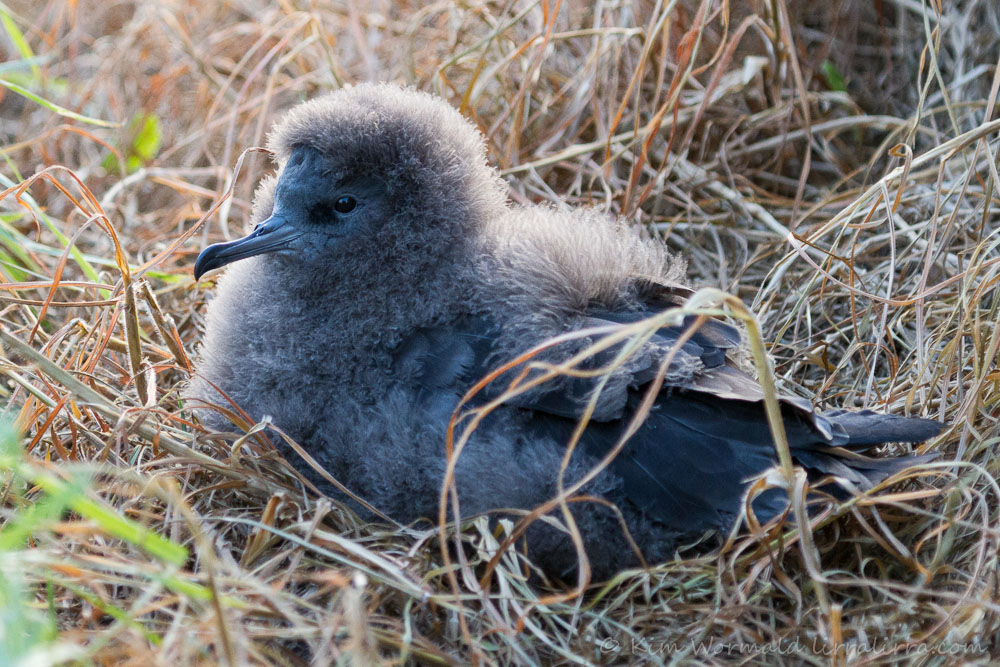 Wedge-tailed Shearwater (Puffinus pacificus)
Wedge-tailed Shearwater (Puffinus pacificus)
Canon 7D, 100-400mm L IS USM, 1/200, f/5.0, ISO 1600, focal length 170mm
We were on the island during May and the shearwater chicks that were still in the sand dunes were not expected to survive the winter. The adult birds leave the island by April, leaving the remaining chicks to fledge without food and make their own way to Papua New Guinea and the Philipines. Adults weigh up to half a kilogram and have a wingspan of almost one metre. It was sad to see the dead and dying birds on the beaches, and somehow even sadder to see this sweet chick and to wonder about its future. Short-tailed Shearwaters have a similar story but are under threat from humans who prefer to see them in recipes than in the wild, information and chick images can be seen by clicking Short-tailed bundle of fluff.
Providence Petrel (Pteradroma solandri)
Canon 7D, 100-400mm L IS USM, 1/250, f/5.6, ISO 640, focal length 160mm
David Attenborough was so fascinated by Providence Petrels on Lord Howe Island that he included footage of them for his series The Life of Birds. He was amazed by the way petrels “fall out of the sky” in response to humans imitating their calls. It is amazing, we witnessed it on the island too, but it is also disconcerting. Petrels are incredibly agile in flight but clumsy on the ground. I couldn’t help but wonder how these large birds would be able to take-off without the help of up-draughts from their preferred landing sites, the cliffs of Mt Gower and Mt Lidgebird. I’ve written to naturalists on Lord Howe Island to ask the question but have not received any replies, which leaves me wondering even more, especially as Providence Petrels are listed as vulnerable on Lord Howe Island and were eaten to extinction by early settlers on Norfolk Island. David Attenborough suggests that they are curious but I wonder if they perceive the sounds as a threat.
I think that Providence Petrels look quite incredible. Their bills are a work of art and I really like their soft brownish grey plumage with the mottled cream on their faces, the scalloped feathering on their heads and their dark, soulful-looking eyes.
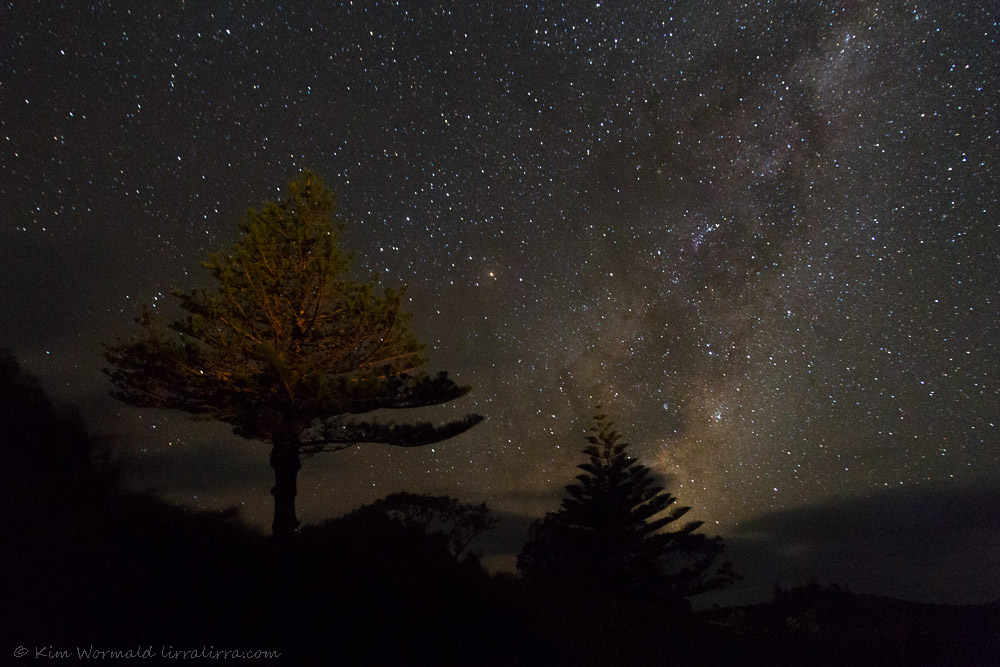 Starry night (Nocte caelum)
Starry night (Nocte caelum)
Canon 7D, EF-S15-85mm, 30.0 sec, f/3.5, ISO 4000
Along with the birds and the beaches, the night sky at Lord Howe Island is also remarkable, thanks to its inherent beauty and the almost total lack of light pollution.
Happy birding, Kim
NB It is now possible to get a weekly email letting you know that lirralirra has been updated – just add your address to the ‘Subscribe to email’ box, above right, and click on the hyper-link when your email arrives.
Also, I recently added a Facebook ‘like’ option. Thanks to all ‘likers’ – I like you too!


Wonderful birds. The digging Woodhen under cover has a bit of the mammalian air of the kiwi. And thanks for the CU of the petrel with its superb bill sculpted by evolutionary forces.
Hi Susan, lovely to hear from you about the Lord Howe post, I’m glad you enjoyed it. I agree regarding the kiwi! The petrel close up was my first image that was given an international award, which was both surprising and awesome – they are truly remarkable birds.
beautiful!
Thank you!
Kim, this is a marvelous, thought-provoking post with delightful images. I hope we can right some of the wrongs we humans have done to nature. And soon.
Thank you Mia, I hope it’s soon too.
Your photos are excellent — absolutely gorgeous.
Thank you George!
KIM, those are STUNNING shots of the birds but I just sigh at your Starry Night! Love love love. Thank you for giving the information you have on the birds too as they are so new to most of us!
Thank you Sherry, it’s a lovely little island, I’m so glad you like the images and info
What a great post! Neat story about the island and the birds. I love all the birds and your starry night shot is awesome! Happy Birding and have a great weekend!
I’m glad you like the woodhen story Eileen, it’s good to hear positive stories isn’t it. Thanks for visiting and you have a good weekend too
Kim, I don’t think your photos can get any better, they are so sharp, the details are amazing.
Thank you Carole, I love seeing the detail too, on my screen I can examine the birds closely without stressing them, I enjoy bird photography so much and really appreciate your kind comments.
ohh what a special story for the Lord Howe Woodhen, i m happy to see serouis decisions done to protect the last species in this family, a bit late but it s better than to do nothing
me too, i find excessive to clean the beak on postraitement, it s much better to give a real picture of this bird
thanks a lot for theses nices pictures, a pleasure to dicover
happy birding too kim
I’m glad you enjoyed the Lord Howe Woodhen story Eric, it is good to see them thriving on the island now. And I’m glad you agree about cleaning the beaks too, it seems like such a strange thing to do when the beaks often have their own story to tell. Au revoir